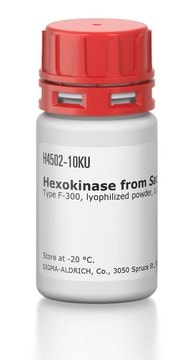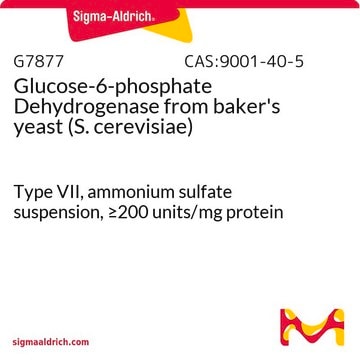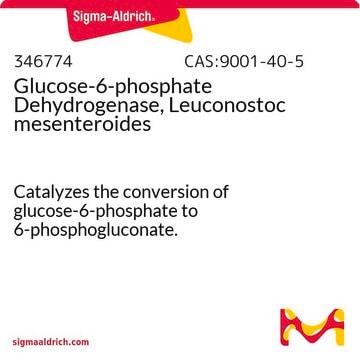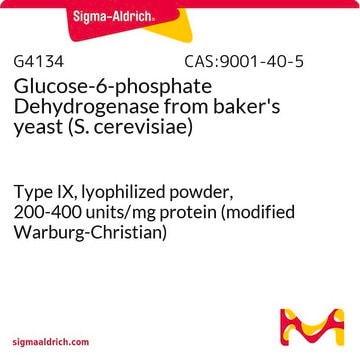H6380
Hexokinase from Saccharomyces cerevisiae
lyophilized powder, ≥350 units/mg protein, Protein ≥10 % by biuret
Synonym(s):
ATP:D-Hexose-6-phosphotransferase, Hexokinase from yeast
About This Item
Recommended Products
biological source
Saccharomyces cerevisiae
form
lyophilized powder
specific activity
≥350 units/mg protein
mol wt
dimer 110 kDa
composition
Protein, ≥10% biuret
manufacturer/tradename
Sigma-Aldrich
technique(s)
activity assay: suitable
color
white
pH
6
application(s)
life science and biopharma
foreign activity
L-Glutamic dehydrogenase ≤0.05%
Creatine phosphokinase, myokinase, 6-phosphogluconic dehydrogenase and alcohol dehydrogenase ≤0.001%
Glucose-6-phosphate dehydrogenase ≤0.005%
Glutathione reductase ≤0.005%
Phosphoglucose isomerase ≤0.002%
storage temp.
2-8°C
Gene Information
bakers yeast ... HXK1(850614) , HXK2(852639)
Looking for similar products? Visit Product Comparison Guide
General description
Application
- to investigate its amyloid fibril forming tendency using biophysical methods
- in tracking ATP depletion in peroxisomes and reticulocyte lysates in import assays
- in the synthesis of Mg-ADP-actin from Mg-ATP actin monomers
Biochem/physiol Actions
The rate of phosphorylation varies with different hexoses (pH 7.5, 30 °C).
D-fructose KM: 0.33 mM
D-glucose KM: 0.12 mM
D-mannose KM: 0.05 mM
Yeast hexokinase exists as two similar isoforms, PI and PII (A and B), with isoelectric points of 5.25 and 4, respectively.
Molecular Weight: ~ 54 kDa (monomer)
~110 kDa (dimer)
Optimal pH: 7.5 to 9.0
Extinction Coefficient: E1% = 8.85 (PI) and 9.47 (PII) at 280 nm
Activators: Hexokinase requires Mg2+ ions (KM = 2.6 mM) for activity. Hexokinase is activated by catecholamines and related compounds.
Inhibitors: sorbose-1-phosphate, polyphosphates, 6-deoxy-6-fluoroglucose, 2-C-hydroxy-methylglucose, xylose, lyxose, and thiol reactive compounds (Hg2+ and 4-chloromercuribenzoate)
Unit Definition
Physical form
Other Notes
Storage Class Code
11 - Combustible Solids
WGK
WGK 3
Flash Point(F)
Not applicable
Flash Point(C)
Not applicable
Personal Protective Equipment
Certificates of Analysis (COA)
Search for Certificates of Analysis (COA) by entering the products Lot/Batch Number. Lot and Batch Numbers can be found on a product’s label following the words ‘Lot’ or ‘Batch’.
Already Own This Product?
Find documentation for the products that you have recently purchased in the Document Library.
Customers Also Viewed
Protocols
Measure hexokinase activity using a continuous spectrophotometric rate-determination assay at 340 nm, catalyzing D-hexose sugar phosphorylation using ATP.
Measure hexokinase activity using a continuous spectrophotometric rate-determination assay at 340 nm, catalyzing D-hexose sugar phosphorylation using ATP.
Measure hexokinase activity using a continuous spectrophotometric rate-determination assay at 340 nm, catalyzing D-hexose sugar phosphorylation using ATP.
Measure hexokinase activity using a continuous spectrophotometric rate-determination assay at 340 nm, catalyzing D-hexose sugar phosphorylation using ATP.
Our team of scientists has experience in all areas of research including Life Science, Material Science, Chemical Synthesis, Chromatography, Analytical and many others.
Contact Technical Service







